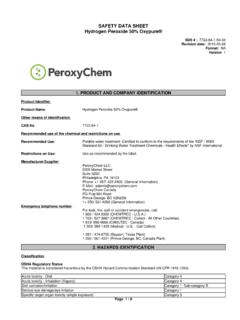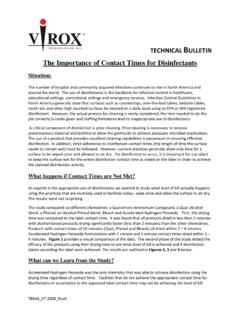Transcription of Stabilized Hydrogen Peroxide - University of Guelph
1 Stabilized Hydrogen Peroxide Dr. Youbin Zheng, Siobhan Dunets and Diane Cayanan University of Guelph , Guelph , Ontario, Canada Background Hydrogen Peroxide (H2O2) is a strong oxidizer that forms when water combines with ozone in the atmosphere. The bonds that hold the Hydrogen and oxygen atoms together ( ) in H2O2 are unstable, which causes the molecule to break along the oxygen-oxygen bond, releasing free hydroxyl radicals (OH) that serve to oxidize organic matter. Fig 1. Hydrogen Peroxide molecule (Wikimedia commons) As with most other chemical water treatment methods, Hydrogen Peroxide disinfects by oxidizing the cell membranes and inner cell structures of pathogens, destroying them.
2 Due to efficacy issues with pure Hydrogen Peroxide solutions, many Hydrogen - Peroxide based disinfection products also incorporate stabilizers such as silver ions, to produce a more stable and powerful disinfectant (Tot et al., 2009). This form of Hydrogen Peroxide degrades slower, allowing it to have a residual effect. This means it remains in the water in low concentrations all the way down the irrigation line for a certain period of time, allowing for extended disinfection throughout the system. Another variety of Hydrogen - Peroxide based disinfectants involve activation using acid addition, to form a compound called peroxyacetic acid. The information below deals primarily with other Stabilized Hydrogen Peroxide disinfectants.
3 Hydrogen Peroxide -based disinfectants can vary widely in composition, which may affect phytotoxicity potential and effectiveness. It is important to examine technical information provided by the producer to determine if a product is right for your intended application. Application method Hydrogen Peroxide compounds are sold in liquid or granular form. They can be applied to irrigation water via an injector system. This system must incorporate a special injector that is resistant to corrosive chemicals and has a high injection ratio (Fisher, 2011). Dosing of high concentrations (shock treatment) can be used to clean the irrigation system. Alternatively, for control of pathogens, low concentrations can be applied in a continuous treatment (Nederhoff, 2000).
4 Safety concerns and handling information Concentrated Hydrogen Peroxide should not be mixed with any pesticides or fertilizers, due to its nature as a strong oxidizer (Fisher, 2011). It may also eventually cause breakdown of plastic greenhouse structures via oxidation (Stewart-Wade, 2011). Proper safety measures must be taken when handling. Hydrogen Peroxide tends to break down fairly quickly to water and oxygen, and as such poses no danger to the environment (EPA, 2002). Critical Levels for Pathogens To our knowledge, no official studies on the effectiveness of non-peracid Hydrogen Peroxide based disinfectants (ex. silver Stabilized Hydrogen Peroxide ) for treating greenhouse pathogens have been performed, as the majority of Hydrogen Peroxide disinfectants are peracid-based.
5 For more information on critical levels for peracid/peroxyacetic acid go here. However, it is likely that critical levels for various pathogens will differ between peroxyacetic acid products and Stabilized Hydrogen Peroxide products. The product Huwa-san (a silver Stabilized Hydrogen Peroxide ) has been shown to be effective for disinfection in other systems (Tot et al., 2009), and has reportedly been used in greenhouse systems. Further studies are needed to determine critical levels required for control of certain pathogens. Critical Levels for Plants As with other chemical oxidizers, Hydrogen Peroxide degrades all organic material, including that of living plant tissue.
6 As such, an excessively high concentration will be harmful to plants. There is very little information available on the phytotoxicity of Hydrogen Peroxide . The table below summarizes the findings of the studies that have been performed. Plants Critical Level (ppm) Lettuce Seedlings (Nederhoff, 2000) HP: 85 Hydroponic Lettuce (Nederhoff, 2000) HP: 8 Cucumber in rockwool (Vanninen and Koskula, 1998) 125 It should be noted that these phytotoxicity levels are for peracid disinfectants, as opposed to other forms of Stabilized Hydrogen Peroxide . As Stabilized Hydrogen Peroxide often incorporates potentially toxic ions, it is likely to have some phytotoxic effect, although how critical levels would compare to peracids is currently unknown.
7 It is recommended, as with any water treatment method, that the producer perform a phytotoxicity test on a small group of plants under simulated production conditions prior to widespread application (Fisher, 2011). This is particularly important for Hydrogen Peroxide due to the lack of information on phytotoxicity. Monitoring Test strips are currently the most convenient means of measuring Hydrogen Peroxide concentration in the irrigation solution (Nederhoff, 2000). Test strips typically cost approximately $1 per strip and can be purchased from producers such as Merck or Quantofix (Nederhoff, 2000). In combination with other technology Like other pathogen control methods that work through oxidation, presence of organic particles in irrigation water decreases the effectiveness of Hydrogen Peroxide -based disinfection.
8 As such, this method should be combined with a filtration system for any water source that may contain particulate organic matter (Newman, 2004). The number and fineness of filters needed will depend on how dirty the water source being used is (see filtration). Hydrogen Peroxide technology (like ozone) can be combined with UV disinfection to increase its effectiveness. If Hydrogen Peroxide is injected before water is subjected to UV light, the UV light will break the bond between the oxygen molecules (decompose Hydrogen Peroxide ), quickly producing hydroxyl radicals which are stronger oxidizing agents that the Hydrogen Peroxide itself (Runia and Boonstra, 2004).
9 However, determining the appropriate initial Hydrogen Peroxide concentration is crucial as excess Hydrogen Peroxide will react with applied UV light, reducing the radiation available for pathogen destruction (Runia and Boonstra, 2004). Excess Hydrogen Peroxide that does not react with UV light may also produce phytotoxic effects when it reaches plants (Runia and Boonstra, 2004). Combining ozone and Hydrogen Peroxide application (peroxone treatment) may also result in improved disinfection (EPA, 1999). The mechanics of this treatment are similar to those of combining UV- Hydrogen Peroxide treatment. Mixing Hydrogen Peroxide and ozone together in solution accelerates the decomposition rate of both (EPA, 1999).
10 When these compounds decompose they produce the stronger-oxidizing hydroxyl radicals. By increasing decomposition rate, more hydroxyl radicals are present in solution at a certain time, and greater oxidation/disinfection can take place. To maximize disinfection potential, ozone should be added to the irrigation solution before the addition of Hydrogen Peroxide . Langlais et al. (2001) combined these treatment methods and successfully controlled various greenhouse pathogens using below-phytotoxic levels of Hydrogen Peroxide . At the same time, the beneficial microbial population of the growth media was maintained. However, because hydroxyl radicals degrade so quickly, monitoring residual levels is currently not feasible (EPA, 1999).





